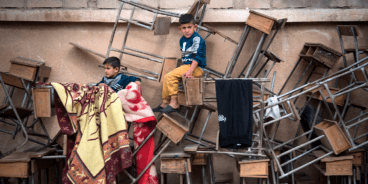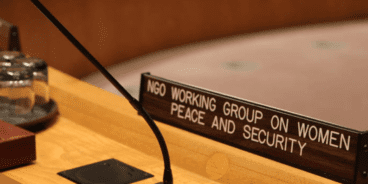
Statement by Dr. Edward Luck on behalf of the Global Centre at the UN Security Council Arria formula meeting on the Responsibility to Protect and Non-State Actors
On 14 December Dr. Edward Luck, member of the Global Centre for the Responsibility to Protect’s International Advisory Board, delivered the following statement on behalf of the Global Centre at the UN Security Council arria formula meeting on the Responsibility to Protect and Non-State Actors.
Your Excellencies, ladies and gentlemen, it is a privilege to speak to this timely meeting on behalf of the Global Centre for the Responsibility to Protect. I congratulate Chile and Spain for organizing both this event and the June meeting of the Global Network of R2P Focal Points in Madrid, which cogently addressed this topic, among others. From the outset, the Global Centre has closely supported the development of the Focal Points Network as one of the surest ways to realize the seminal commitments to protect populations undertaken at the World Summit a decade ago. All of us associated with the Global Centre are also most appreciative of the initiatives by France and Mexico and by the ACT coalition to encourage Member States to facilitate a rapid and united international response to atrocity crimes.
Today’s session embodies the Council’s determination to find more inclusive and inter-active formats for addressing rapidly evolving threats to international peace and security. As the Secretary-General’s most recent report on R2P acknowledges, the normative progress in gaining wide international acceptance of R2P as a principle has not been matched by comparable progress on the ground in protecting populations from genocide, war crimes, ethnic cleansing, and crimes against humanity, as well as their incitement. If anything, the rising tide of forcibly displaced populations to levels not seen since World War II offers tragic testimony to our individual and collective failure to fulfill the commitments made so solemnly at the World Summit.
The initial conception of R2P was too state centric. It failed to appreciate how critical non-state actors could be to preventing such crimes or, regrettably, to committing them. States were viewed as the problem and the solution was seen to rest with inter-state bodies, particularly this Council. True, sovereignty had been—and continues to be—invoked inappropriately by state authorities intent on committing atrocities against their own people. Undoubtedly there continue to be more victims of atrocities committed by governments than by non-state armed groups. But the rise of violent extremism by groups with highly sectarian agendas, such as Boko Haram, ISIL, and Al-Shabaab, underscores that the inability of states to exercise effective sovereignty over parts of their territory can also contribute directly to the commission of atrocity crimes.
In my work as Special Adviser, I saw many situations in which R2P was an ally, not an adversary, of state sovereignty. Sovereignty demands responsibility, first and foremost in protecting populations. States should encourage and facilitate the efforts of domestic and transnational civil society to counter incitement, hate messaging, and the targeting of minority groups, to mediate disputes and conflicts among ethnic or religious communities, and to engage in impartial fact- finding, monitoring, reporting, and, when conditions warrant, early warning and unarmed civilian protection. Mass atrocities feed off of intolerance, systematic discrimination, separatism, and ignorance. In places where rights and diversity are respected, no community is regularly excluded from political processes, inter- communal dialogue is facilitated, and the government’s exercise of legitimate authority is not geographically circumscribed, there is little room for groups or leaders with highly sectarian and violent agendas.
Responsibility needs to be understood as a bottom-up, as well as a top-down phenomenon. If it is practiced within communities and societies, then the role of the international system can be one of support and engagement rather than of reaction and intervention. We know from sad experience that the latter is usually too little, too late. Even when this Council can agree on a course of action, its decisions tend to be ignored by armed groups that are intent on flouting international norms and institutions. Mass executions, rape, and forced displacements become part of their very identity: their warped declaration of independence from international authority.
The Security Council and the United Nations system, working with civil society and regional partners, do have essential parts to play in defeating these groups. What is needed is a six-part, people-first strategy of denial, as follows:
-
- One: denial of legitimacy and credibility. Affected populations need to be assured that national and international authorities, unlike armed groups, will consistently respect human rights, refugee law, and international humanitarian law, as well as do a better job than armed groups at improving the lives of local populations. To that end, the values expressed in R2P principles should not be subsumed by the distinct, if often parallel, struggle to counter terrorism. R2P principles must be applied universally and impartially, not just in places where terrorism presents a threat to the wider international community.
- Two: denial of space and time. Populations cannot be protected if armed groups are allowed to occupy territory for any sustained length of time. Armed groups that commit atrocity crimes must be defeated decisively. They cannot be allowed to use captured territory as sanctuaries and training grounds and local populations as their property to be abused at will. With host country consent, regional or international military assistance to defeat such groups can be an integral part of Pillar Two of the Secretary-General’s implementation strategy.
- Three: denial of financial and material resources. It is a positive step that this Council is seeking the participation of finance ministers in its efforts to counter terrorism and violent extremism. But a similar wide-ranging effort is needed to find ways of cutting off the financing of armed groups that incite and/or commit atrocity crimes. This Council and its sanctions committees have developed great expertise on designing and monitoring targeted sanctions and on tightening curbs on illicit sources of income, whether from narcotics, human trafficking, transnational crime, or commodities trading. All Member States should ensure that their institutions and people are not involved, directly or indirectly, in trade with or assistance to groups or individuals involved in the commission or incitement of atrocity crimes. This is one way that they can assist “states under stress before crises and conflicts break out,” as called for in paragraph 139 of the 2005 Outcome Document.
- Four: denial of the means of committing mass crimes. Even genocide on the scale of Rwanda or Cambodia does not necessarily require advance weaponry, but it does require large scale mobilization and the international community to look the other way. Implementation of the Arms Trade Treaty, closer monitoring of sensitive borders, restrictions on the travel of arms dealers involved in gun running, and stepped up efforts at disarmament in conjunction with UN and regional peacekeeping could make it more difficult or expensive for groups intent on committing mass violence to acquire the means. In the end, however, governments are responsible for ensuring that they retain a monopoly on the acquisition and use of force on their territory. Neighboring states and civil society groups can serve as watchdogs, while visits undertaken or authorized by this Council, utilizing its robust investigative authority under Article 34, may be helpful in supplementing national capacity in some situations.
- Five: denial of impunity. The jury is still out on whether the existence of international tribunals has had a deterrent effect on those contemplating the commission of atrocity crimes. Either way, there are several reasons for the Council to continue to refer such cases to the International Criminal Court (ICC) or to ad hoc regional tribunals. One, this possibility is one of the handful of levers that the Secretary-General and other envoys can invoke in their appeals to would-be perpetrators to refrain from taking the path to mass atrocities. Two, vulnerable populations and survivors need to retain hope that justice, in some small measure, might prevail in the end. And three, such actions tend to reinforce the norm that such crimes are unacceptable and to underscore that the Council remains vigilant in its efforts to discourage such violence against vulnerable populations.
- Six: denial of an audience for incitement, radicalization, and recruitment. As the Council has recognized, one of the most disturbing aspects of the rise of armed groups intent on committing atrocity crimes has been their capacity to appeal to potential sympathizers or recruits domestically and abroad. When stripped of their emotional, ideological, and religious façade, their promotional videos and narratives are little more than the kind of incitement to mass violence against specific populations that was explicitly proscribed by the Outcome Document of the 2005 World Summit. Governments and inter-governmental bodies, such as this Council, need to counter this messaging and to interfere, to the extent possible, with its transmission. But this is an area in which civil society, including educational and religious leaders, should be in the vanguard.
Each of these points, but especially the sixth one, underscores the ultimate importance of individual as well as collective responsibility. Through my work as both a practitioner and student of R2P, it has become increasingly apparent that its appeal to ‘we the peoples,’ especially to younger people wary of repeating the mistakes of earlier generations, is its greatest strength over the long haul. That is why my wife, Dr. Dana Luck, and I are developing the theory and practice of the Individual Responsibility to Protect (IR2P) as a complement to the state-centric conception of R2P.2 People have to say no to those who try to justify mass killing and mass sexual or gender-based violence by appeals to sectarian identity. They have to understand that nothing could justify such actions and they need to be willing to stand against such appeals. If they do, then R2P will have made an historic difference and your vital work will become a lot easier. Thank you.
Related Content


